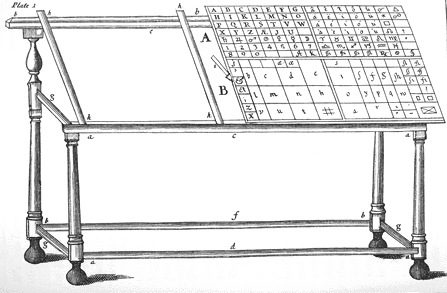
A type case, from Joseph Moxon, Mechanick Exercises on the Whole Art of Printing, London, 1683.
Collation is concerned with how the manuscript was put together. For this manuscript, the short hard
collation is as follow: “Parchment, fol. i + 41; 1⁸ 2⁶ 3-4⁸ 5¹⁰; quires signed a-e.” This complex equation simply means that the manuscript is comprised of 1 folio of forty-one parchment leaves and that there are five quires (five gathering of text, in this case letters, comprise this manuscript). The first quire has eight pages, the second has six, the third and fourth are grouped together and have a total of eight pages, and the last quire has ten pages. Furthermore, each quire is identified by a specific letter (quire 1 is a, quire 2 is b, quire 3 is c, quire 4 is d, and quire 5 is e). Such careful collation annotations— especially the labeling of the quires— reveals that this was a manuscript produced after the thirteenth-century, when such numbering systems became standard (Brown, 1994 105).
collation is as follow: “Parchment, fol. i + 41; 1⁸ 2⁶ 3-4⁸ 5¹⁰; quires signed a-e.” This complex equation simply means that the manuscript is comprised of 1 folio of forty-one parchment leaves and that there are five quires (five gathering of text, in this case letters, comprise this manuscript). The first quire has eight pages, the second has six, the third and fourth are grouped together and have a total of eight pages, and the last quire has ten pages. Furthermore, each quire is identified by a specific letter (quire 1 is a, quire 2 is b, quire 3 is c, quire 4 is d, and quire 5 is e). Such careful collation annotations— especially the labeling of the quires— reveals that this was a manuscript produced after the thirteenth-century, when such numbering systems became standard (Brown, 1994 105).